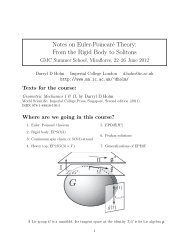Control´Optimo de Sistemas Mecánicos Actuados ... - GMC Network
Control´Optimo de Sistemas Mecánicos Actuados ... - GMC Network
Control´Optimo de Sistemas Mecánicos Actuados ... - GMC Network
You also want an ePaper? Increase the reach of your titles
YUMPU automatically turns print PDFs into web optimized ePapers that Google loves.
6.2. SISTEMAS VARIACIONALES NOHOLÓNOMOS Y CONTROL ÓPTIMO 43<br />
Teorema 6.2.1. Bajo la transformación (6.7), el sistema <strong>de</strong> Euler-Lagrange (6.4) es transformado<br />
en el sistema Hamiltoniano<br />
don<strong>de</strong><br />
˙q = ∂<br />
H(q, p) (6.8)<br />
∂p<br />
˙p = − ∂<br />
H(q, p),<br />
∂q<br />
H(q, p) = p · φ(q, p) − L(q, φ(q, p)). (6.9)<br />
Demostración: El echo <strong>de</strong> que Φ(q, φ(q, p)) = 0 implica que<br />
∂Φ<br />
∂q<br />
Entonces, usando (6.5), obtenemos que<br />
De manera similar,<br />
∂H<br />
∂q<br />
= −∂L<br />
∂q +<br />
∂H<br />
∂p<br />
<br />
p − ∂L<br />
∂ ˙q<br />
= φ +<br />
∂φ<br />
∂p<br />
∂Φ ∂φ<br />
+<br />
∂ ˙q ∂q<br />
∂Φ ∂φ<br />
∂ ˙q ∂p<br />
<br />
p − ∂L<br />
<br />
∂φ<br />
∂ ˙q ∂p<br />
= −∂L<br />
∂ ˙q<br />
+ λ<br />
= 0.<br />
∂Φ<br />
∂ ˙q<br />
= 0<br />
= ˙q + λ<br />
∂Φ<br />
∂ ˙q<br />
<br />
∂φ<br />
= ˙q.<br />
∂p<br />
<br />
∂φ ∂L<br />
= − + λ∂Φ = −<br />
∂p ∂ ˙q ∂q<br />
∂Λ<br />
∂q<br />
= − ˙p.<br />
Definición 6.2.2. Sean q ∈ Rn , u ∈ Rm el Problema <strong>de</strong> Control Óptimo viene dado<br />
por<br />
T<br />
mín<br />
u( · ) 0<br />
g(q, u) dt, (6.10)<br />
sujeto a<br />
˙q = f(q, u),<br />
con condiciones <strong>de</strong> bor<strong>de</strong> q(0) = 0, q(T ) = qT<br />
Con esta <strong>de</strong>finición tenemos el siguiente resultado:<br />
Teorema 6.2.3. El problema Lagrangiano (6.4) y el problema <strong>de</strong> Control Óptimo <strong>de</strong>finido<br />
arriba generan las mismas trayectorias extremales, si y sólo si:<br />
1. Φ(q, ˙q) = 0 si y sólo si existe u tal que ˙q = f(q, u).<br />
2. L(q, f(q, u)) = g(q, u).




